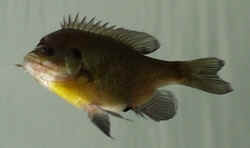 |
 |
Redear Sunfish
Other Names: Shellcracker, Stumpknocker, Yellow Bream
Scientific Name: Lepomis microlophus
Family Name: Centrarchidae
 |
 |
A popular panfish in the southern United States, it is regionally known there as the shellcracker, stumpknocker, and yellow bream. The redear can be distinguished from the pumpkinseed, which it most closely resembles, by the lack of spots on the dorsal fin and of bluish bands on the sides of the head. The gill flap of the redear is semiflexible, bending to right angles; that of the pumpkinseed is rigid. The body color is variable, from bronze to blue-green with darker spots. There are 5 - 10 dusky vertical bars on the sides. The gill flap has a whitish border, with the tip accented with a bright red spot on the male and orange on the female. The mouth is small, but not extending beyond the front of the eye, and the pectoral fins are long and pointed. Redear sunfish of over 4 pounds have been caught in Florida, North Carolina, and Virginia. The record is 4 1/2 pounds (1970). The original range of the redear was south of the range of the pumpkinseed from southern Illinois south to Florida and Texas. In recent years it has been stocked in many states just north of its natural area, and in some western states, notably New Mexico. The redear has a definite preference for large, quiet waters and has a tendency to congregate around stumps, roots, and logs. It frequents open waters and seems to require less vegetation than the pumpkinseed. The redear has been widely introduced into farm ponds because it is believed to be less prolific than the bluegill and therefore less likely to cause an overpopulation of stunted fish. It depends largely on mollusks for food and does not compete severely with insect-eating fish. The redear has highly developed grinding teeth or "shell-crackers' located in its throat, which are capable of crushing snails -- its favorite item of diet. [A.J. McClane, McClane's Field Guide to Freshwater Fish of North America, Henry Holt and Company, New York, 1978]